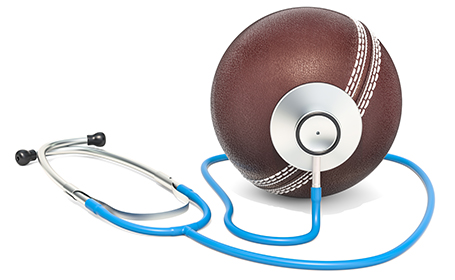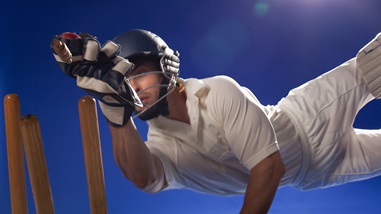
Common cricket injuries
Whether you bat, bowl or field, there's a risk of getting injured - either due to overloading or from impact injuries. Injuries usually occur either at the start of the cricket season (when workloads suddenly increase) or at the end (from the increasing effect of the season).
Here are the 8 most common acute cricket injuries:
1. Rotator cuff injuries
What is it? Your rotator cuff is a set of four muscles which help to stabilise the shoulder joint. Any damage is likely to make bowling, fielding and batting painful. Repetitive movements can lead to an overloading of tissue. As bowlers and fielders use their shoulders a lot, they’re at risk of rotator cuff injuries. If you have a tendon injury, you will usually experience a gradual ache down the upper arm, whilst muscle strains are common with a sudden sharp movement. Harvard Health states injuring your rotator cuff is quite easily done because the tendons within your rotator cuff are part of a very tight space.
How to treat it: A lack of flexibility and strength can put you at a greater risk of injury. This can be improved by a structured rehabilitation programme from a physiotherapist. If the problem persists, surgery may need to be considered.
2. Medial meniscus tear
What is it? The medial meniscus is a C-shaped area of cartilage located at the top of the tibia bone in your lower leg. It helps to protect the knee joint from the stress of running, walking and bending, so it's no wonder a torn medial meniscus is a common cricketing injury.
Injuries can happen as you turn quickly to run, but they can also occur slowly over time through wear and tear. If you have a medial meniscus tear, you may feel pain on the inside of the knee, discomfort when squatting or bending, or have swelling in the area.
How to treat it: A physiotherapist can help you manage the condition. If the pain persists or you experience locking of the knee, you may require a knee arthroscopy (keyhole surgery) to diagnose the extent of the injury and decide the right course of treatment.
A sprained ankle refers to damaged ligaments and soft tissue. This often happens when the ankle twists inwards.
3. Ankle sprain
What is it? Like knees, ankles are put under a lot of strain during cricket too. A sprained ankle refers to damaged ligaments and soft tissue. This often happens when the ankle twists inwards and can sometimes occur when bowlers land in old foot marks at the bowling crease or when batsmen turn from running.
How to treat it: Physiotherapy can be extremely beneficial in prevention, rehabilitation, and improving strength.
After an acute ankle sprain, the NHS recommends following the PRICE protocol to help the healing process:
- Protection
- Rest
- Ice
- Compression
- Elevation
PRICE should be applied as early as possible after injury and continued for at least the first 24-72 hours. Wearing an ankle brace or taping can help to protect the injury but in severe cases, surgery may be required.
4. Contusions
What is it? Contusions are caused by a direct impact to the muscle, most likely from being struck by a ball. When this happens, you may experience swelling or bruising, as well as some loss of movement in the muscle, depending on how severe the damage is.
How to treat it: Contusions are classed depending on how serious they are, starting at Grade one (mild bruising with a little pain at the site of impact) and going up to Grade three.
Grade three contusions are the most severe. If you suffer this form of injury you might need some rehabilitation from a physiotherapist before you can return to the pitch.

5. Thrower’s elbow
What is it? Thrower’s elbow (the same condition as golfer’s elbow) is medically known as medial epicondylitis. Pain is felt on the inside of the elbow and can often occur at the start of the season due to a sudden increase of workload or at the end of season due to fatigue. Throwing technique can often be a key factor so working with a coach may be helpful.
How to treat it: Ice can help to ease acute pain that may be felt during a match, while heat may be more beneficial when the injury becomes chronic.
Strengthening, stretching and ultrasound are commonly used effective techniques available from a physiotherapist. If the problem persists and is limiting your activities, then a surgical opinion may be required.
6. Side/intercostal strain
What is it? Bowling requires a large amount of side bending, placing the lateral muscles under a great amount of repetitive strain. Pain may occur in muscles in between the ribs (intercostal) or in the muscles in the side of your abdomen/loin. The injury usually presents with a sudden, sharp onset and often when bowling, although smaller strains may feel like stiffness.
How to treat it: Regular stretching, strengthening and soft tissue work with a health professional can help reduce the risk of such injuries.
Rehabilitation of the injury often follows a similar path. Like all muscle tears, the length of recovery is dependent on the size of the tear, with most side strains taking between two and ten weeks to recover.
7. Lower back pain
What is it? General lower back pain can be difficult to diagnose as there are so many structures and tissues in this area. Bowling requires a lot of movement, extension and rotation, which places the back under pressure. Repetitive movements can cause low back pain to gradually worsen over a season. Muscle strains are not uncommon, as are herniated/slipped discs. Young bowlers (16-24 year olds) are at a risk of stress fractures, where the repetitive loading of the lumbar spine (lower back) leads to bone damage. Symptoms usually include pain in the lower back, which can become worse when standing or arching backwards.
How to treat it: A structured rehabilitation programme with a physiotherapist and pilates sessions can help manage the condition and ease symptoms.
Young bowlers with stress fractures can be assessed by a physiotherapist, but you may also need an MRI scan to diagnose the problem. Treatment requires rest from the repetitive stress on the lower back and gradual rehabilitation to return to sport.
Recovery times from this type of injury are likely to take three to four months. However the earlier this condition is diagnosed the quicker the recovery time can be.
Fractures of the fingers may at first be managed by a hand therapist, who could also provide personalised protective appliances to be worn.
8. Impact injuries to your fingers
What is it? All players are at risk of bony bruising or fractures. A hard leather cricket ball can easily do damage to your fingers whether you are fielding, wicket-keeping or batting. Improving grip strength has been shown to reduce the prevalence of finger fractures in cricket.
How to treat it: Bruising can be managed through the PRICE protocol.
Fractures of the fingers may at first be managed by a hand therapist, who could also provide personalised protective appliances to be worn. More severe fractures may require corrective surgery by an orthopaedic surgeon. An X-ray would be required to ascertain the full extent of the damage and therefore the best treatment option.
If your injury persists and is making everyday activities difficult, it might be a good idea to see a physiotherapist.
A physiotherapist can accurately assess and guide you on the correct course of treatment you need to return to full fitness and get back on the pitch.
Get help for your cricket injury at Circle Health Group
If you'd like to speak with one of our physiotherapists about getting help for your cricket injury, you can book an appointment with one online today. You can also speak with an orthopaedic consultant if you need treatment for a joint injury, such as thrower's elbow.
Tags
How do I book an appointment?
If you're concerned about symptoms you're experiencing or require further information on this subject, talk to a GP or see an expert consultant at your local Circle Hospital.